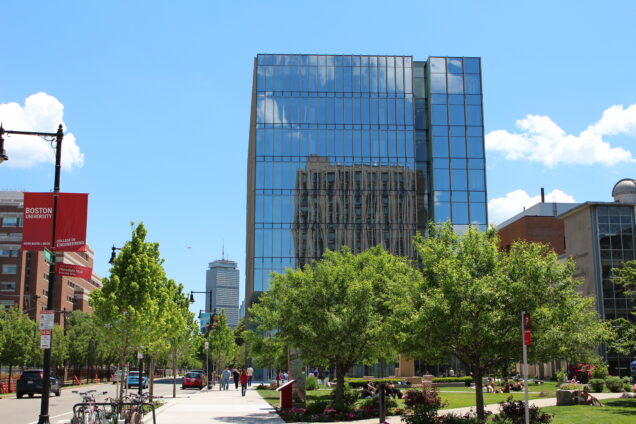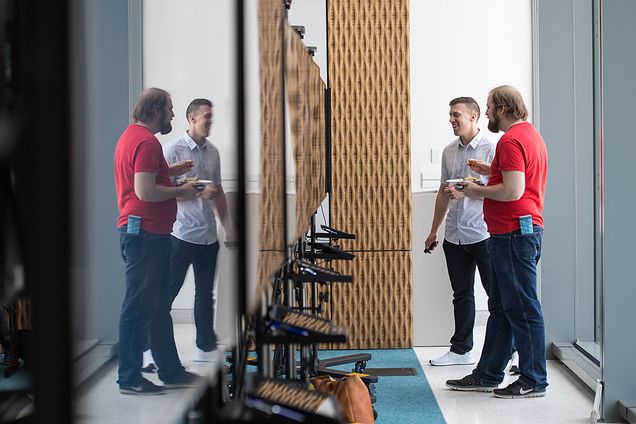Symposium Celebrates Grand Opening of Biological Design Center
Kickoff Event Highlights Multidisciplinary Work in Biological Design
By Sara Cody
More than 200 researchers from industry, academia and healthcare gathered on campus June 1 to celebrate the formal launch of the Biological Design Center and its new home, the just-completed, nine-story Center for Integrated Life Sciences and Engineering (CILSE).

According to Professor Christopher Chen (BME, MSE), founding director of the BDC, bringing together the community to explore synthetic biology — the engineering of living systems to understand, control, and reengineer how biological components work — is a key component of the mission.
“The purpose of the center is to build a new community not just of faculty working on individual projects, but all of us working together,” said Chen. “While not every BDC faculty member will be located in CILSE, having a central location acts as a catalyst for everybody to interact with each other and establish new collaborations.”
The kickoff symposium, titled “Engineering the Future,” featured an array of speakers from academia and industry who gave presentations on biological science and technology, as well as their work with diverse aspects of biological design ranging from molecular-scale investigations to tissue-level engineering and multicellular communities and communication. The community gathered in the Hariri Auditorium in the Questrom School of Business to listen to the speakers before heading over to two poster sessions in the CILSE lobby, one at lunch and one in the evening, showcasing some of the research projects that BDC members have been developing.

“Our vision is to use the center to branch out and make strong connections across the community, both in academia and in industry,” said Chen in his opening remarks. “Connectivity across engineering, biology, physics, chemistry, medicine will be needed to make the vision a meaningful reality.”
Deboki Chakravarti, a PhD student in Assistant Professor Wilson Wong (BME)’s laboratory, was among the lineup of presenters during the morning session. She spoke to the audience about her research project that focuses on engineering T cells—an important component in the body’s immune response — to provide the ability to tune the cells’ behavior in the body. This would enable doctors to enlist the patient’s own cells to fight against diseases like cancer.
“I’ve been in graduate school for a few years and the kickoff event was an exciting opportunity for me to have my first experience presenting my work in a formal setting,” said Chakravarti. “It was great to interact with people outside of academia and in other industries, which I think is a key component of the mission of the BDC.”
Professor Bonnie Bassler, chair of the Microbiology Department at Princeton University, presented the Charles Cantor Lecture, named in honor of Professor Emeritus Charles Cantor (BME), who pioneered a method for separating large DNA molecules, an important tool for biological research. Bassler’s presentation focused on bacterial quorum sensing, or the “languages” that bacteria use to communicate with each other to perform group tasks, and how to synthetically manipulate those systems to combat disease and improve human health.
“Charles’ contributions to science are significant and his early support of synthetic biology helped to cultivate an environment of creativity, tinkering, unconventional thinking that we still maintain today and really helped put BU on the map,” said Assistant Professor Ahmad “Mo” Khalil (BME), associate director of the BDC. “Bonnie’s research spans everything from everything from the science of a complex biological system to inspiring new tools that synthetic biologists use that she elucidated and all the way to human health implications. Her work speaks to the importance of team-based efforts and that synergizes well with the BDC.”
Other presenters at the symposium included BDC faculty Associate Professor Douglas Densmore (ECE), Assistant Professor Allyson Sgro (BME), Associate Professor Pankaj Mehta (CAS) and Assistant Professor Mary Dunlop (BME) and BDC laboratory team members, as well as distinguished speakers from academia and industry. A full list of presenters, including guest speakers can be found here.
CILSE, which recently completed construction, boasts 170,000 square feet of space that brings together investigators in life science, engineering and medicine from both Charles River and Medical campuses. The BDC headquarters is located on the fourth and fifth floors of CILSE, which hosts six laboratories and the administrative offices, as well as collaborative space available to all BDC investigators.